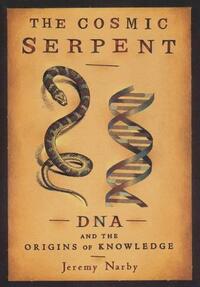Take a photo of a barcode or cover
Great book, so interesting. I think it falls down when he tries to fit his theory into a scientific framework. I don't know if it can be done and I don't think his testing methods are very robust. His theory could be an insightful look into the great mystery of life or it could be riddled with confirmation bias. This book didn't really prove it one way or the other. But it's a great thought-provoking read.
Hey did you guys know that, um, sometimes people do drugs and see a snake? That's like, um, DNA, because you know, um, DNA is like, long and thin, you know? Like, the shape of a DNA is kinda snakey
Loved this book. Really interesting connections between shamanic hallucinations and DNA. Regardless of wether you believe it or not I find it very intriguing. I also like the part about the unlikeliness of the beginning of life happening by chance, but if you do believe it happened by chance you have to take it on as much faith as a religious person takes the existence of God.
Began reading this in 2007. Finally returned to finish it in 2020. So glad I did.
Interesting if you read it as science-fiction.
I didn't know how mad the author was, so I read it hoping It was a good anthropology book. But It isn't. When you notice where is it ending up, you don't know whether laugh or cry.
I didn't know how mad the author was, so I read it hoping It was a good anthropology book. But It isn't. When you notice where is it ending up, you don't know whether laugh or cry.
informative
reflective
medium-paced
This was a very interesting book. Written in the first person, the author describes his experiences with the shamanic culture of the Amazon and their use of ayahuasca to gain knowledge. Comparing various fields such as anthropology, biochemistry, biology, and physics, Narby makes comparisons between the cosmic serpents and celestial ladder so prominent in diverse shamanic cultures to DNA. He has some intriguing hypotheses about "junk DNA" and parallels between scientific discoveries and the visions of the ayahuasqueros. I'm not sure how I feel about all of his conclusions, but I am fascinated about all the parallels he finds. I do agree that we need to take a broader look in science and not just try to pigeon-hole or limit ourselves to one particular field. I like the wholistic approach he takes and the validation he gives indigenous culture. He talks about the need for natives to have more control over intellectual properties as far as the use of native plants goes. Pharmaceutical companies take the native plants and simulate the molecular components giving almost nothing to the indigenous people that have shared their knowledge. I like that he tries to understand rather than just dismiss the belief system that has been passed down through generations. He discusses the problems of indigenous people trying to live in the competitive world that is the modern age and even discusses the problems of using western schooling to try and teach people who have such a different way of learning. As I read this book, I found myself wondering how many of these native lands remained unplundered. The native Amazonian people and their cultures are under constant attack by governments and institutions who claim that they are not adequately using their resources. Part of Narby's original intent was to show how efficiently their resources were being used. Narby is not an expert in the scientific areas that he uses to find the links, but he does extensive research and gives us a lot to think about. My biggest concern would be that we often find the evidence most likely to support our predisposed conclusions and I wonder if that might not be the case with some of what he has come up with. Still, it is fascinating and his conclusions certainly left me with a lot to contemplate.
adventurous
informative
slow-paced
I was now of the opinion that DNA was at the origin of shamanic knowledge. By “shamanism,” I understood a series of defocalization techniques: controlled dreams, prolonged fasting, isolation in wilderness, ingestion of hallucinogenic plants, hypnosis based on a repetitive drumbeat, near-death experience, or a combination of the above. [loc. 1410]
Narby's hypothesis is that shamanic ritual, and in particular the use of botanical hallucinogens ('plant-teachers'), allows indigenous peoples to access botanical and medical knowledge imparted at the molecular level via DNA. He's a hands-on experimenter, and his own experiences of ayahuasca -- a complex preparation, which shamans claim was taught to them by the plants -- inspired his theory that hallucinations and visions of entwined snakes, vines etc actually represent DNA. He theorises that the rituals and preparations allow humans to perceive the weak, colourful photons emitted by DNA.
I am not at all sure what I think about Narby's theories, but I am willing to accept that there are ways of understanding the world that do not conform to the scientific method. Narby writes "The problem is not having presuppositions, but failing to make them explicit. If biology said about the intentionality that nature seems to manifest at all levels, 'we see it sometimes, but cannot discuss it without ceasing to do science according to our own criteria,' things would at least be clear. But biology tends to project its presuppositions onto the reality it observes, claiming that nature itself is devoid of intention." [loc. 1818] Some of the studies he cites, and some of the arguments he makes, seem credible: at other points, such as his discussion of the role of 'wise serpents' in mythology, I was less convinced.
The book itself could have done with better proofreading and better conversion to ebook format: I was especially vexed by the rendering of large numbers, which did not superscript the powers. 'there is 1 chance in 20 multiplied by itself 200 times for a single specific protein to emerge fortuitously. This figure, which can be written 20200, and which is roughly equivalent to 10260, is enormously greater than the number of atoms in the observable universe (estimated at 1080)' [loc. 1023] ... Or 20200, 10260, 1080...
An interesting read and an intriguing theory, but perhaps not as engaging (or convincing) as the author intended -- and more about his personal experience and beliefs than about the science of hallucinogens and the visions they create. Kudos to Narby for openmindedness and rejection of colonial mindsets.
A captivating cross discipline look at reality and knowledge.


